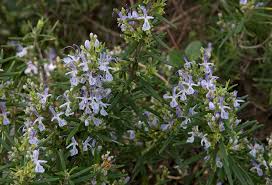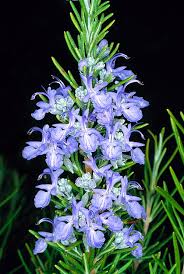
Master of Pharmacy. Khaled Zein Eddine
Savory herbs are flavoring agents and, like spices, are used in cookery to season, enrich, or otherwise alter the flavor and odor of certain foods to make them more pleasing to the taste.
Nowadays, food professionals continually search for unique spice flavorings because of the growing global demand for authentic ethnic and cross-cultural cuisines.
Spices are plants with intensive and distinctive flavours and aromas used in fresh or dry form.
Consumers are also seeking natural foods and natural preservatives for healthier lifestyles and natural ways of preventing ailments.
Rosmarinus officinalis L. Family: Lamiaceae
Common Names: Rosemary
BOTANICAL DESCRIPTION, DISTRIBUTION. Rosemary, Rosmarinus officinalis L., is an evergreen, perennial shrub native to the chalky, calcareous hills along the Mediterranean Sea. Reaching a height of up to 1.8 meters, the plant is characterized by linear, narrow leaves whose undersides are matted with thick hair (Appendix G). Leading areas of rosemary production are the Mediterranean countries, the United States, and England. DELETE!?32?. Rosemary is a native Lebanese medicinal plant. DELETE?19?
CONSTITUENTS. The volatile or essential oil of rosemary includes 1,8-cineole, pinene, camphor, bornylacetate, camphene, linalool, d-limonene, borneol, myrcene, terpineol, and caryophyllene. The oil is extracted from flowering tops, stems, and leaves by steam distillation or the use of organic solvents. An oleoresin is also commercially available. ?32?
PHARMACOLOGICAL ACTION AND MEDICINAL USE WORLDWIDE. As a medicinal plant, rosemary has been used as an external stimulant and as a relaxant for nervousness, muscle spasms, and headaches. Rosemary has been used as an expectorant and as a folk remedy against asthma, eczema, rheumatism, and wounds. It has been used in the treatment of cancer, and is categorized today as a therapeutic emmenagogue ?32?. The inhibitory effect of rosemary is bacteriostatic at 0.3%, whereas 0.5% 0.5% is bacteriocidal for 22 gram negative and 24 gram positive bacteria. Rosemary exhibits potent activity against gram positive bacteria. This is attributed to terpene fraction , which is composed of borneole, aneole, pinene and camphor. In rosemary, carnosic acid has been described as the most active antioxidant constituents. Other phenolic compounds, e.g. rosemaric acid, which has in model system an activity comparable to that of caffeic acid. ?29?
The volatile oil of Rosmarinus officinalis exhibits considerable inhibitory effect against twenty-five different genera of bacteria and one fungal species, that included animal and plant pathogens, food poisoning and spoilage bacteria and the spoilage fungus Aspergillus niger. The oil also possess antioxidant capacities ?24?
The effect the aqueous and ethanol extracts of Rosmarinus officinalis L. aerial parts on morphine withdrawal syndrome was investigated in mice. The aqueous and ethanol extracts induced a significant antinociceptive activity in the writhing test. The aqueous and ethanol extracts of R. officinalis aerial parts could diminish morphine withdrawal syndrome. ?20?
CULINARY AND FLAVOURING USE. Dried rosemary leaves, whole or ground, are used as seasonings for soups, stews, sausages, meat, fish, and poultry. The essential oil is used in food products. Rosemary is also used in nonalcoholic beverages. The plant and extracts have antibacterial and antioxidant activity and can be used to extend the keeping quality of fats and meats. ?32?
Hyssopus officinalis L . Family: Lamiaceae
Common Names: Hyssop
BOTANICAL DESCRIPTION, DISTRIBUTION Hyssop, Hyssopus officinalis L., is a perennial subshrub native to southern Europe, the Mediterranean region, and temperate Asia and naturalized in the United States. Sometimes classified as Hyssopus aristata Godr. or Hyssopus vulgaris Bubani, hyssop is produced commercially in France and several other European countries. The plant reaches a height of 0.5 to 1 meter and bears small blue flowers on a terminal spike. ?32?. The hyssop plant has a woody stem-base, from which herbaceous shoots bearing flowers grow each year. Tops rise from the perennial root-crown each season. The leaves are entire, up to 3 inches lineal, long and slender (appendix B). The whole plant has a pungent, bitter taste. DELETE?28? Hyssop is a native Lebanese medicinal plant. DELETE?19?,?31?
CONSTITUENTS. The essential oil is extracted by steam distillation. The content of essential oil is rather low (0.3 to 0.9%); it is mostly composed of cineol, pinene and a variety of bicyclic monoterpene derivatives (L-pinocamphene, isopinocamphone, pinocarvone). ?18?.. The oil also contains pinocamphone, camphene, terpinene, pinocampheol, 1,8-cineole, linalool, terpineol and other compounds ?32?.
As many other plant of the mint family, hyssop contains rather large amounts of bitter and antioxidative tannins, phenols with a diterpenoid skeleton (carnosol, carnosolic acid), depsides of coffeic acid (= 3,4-dihydroxycinnamic acid) and several triterpenoid acids (ursolic and oleanolic acid). Very similar or the same compounds have also been found in sage and rosemary. ?18?.
PHARMACOLOGICAL ACTION, MEDICINAL USE WORLDWIDE. As a medicinal plant, hyssop has been used as a carminative, diaphoretic, emmenagogue, expectorant, stimulant, stomachic, and tonic. Leaves have been used as a poultice to remove discoloration around bruised eyes and as a remedy for asthma, rheumatism, sore throats, wounds, ulcers, and tumors ?32?.
CULINARY USE Hyssop has only small value as a spice, because the aroma is weak (and reduced to nil after drying), and its taste is rather bitter. It can, however, be used for robust, rustic dishes like potato or bean soup, and it goes well with fat meat; others suggest it to spice up calf and chicken, where it may be an interesting alternative to sage, whom hyssop resembles in its slight bitterness, but not in fragrance. Sometimes, hyssop is added to bouquet garni. ?18?.
The green parts are used in making absinthe, as pot herbs, and occasionally in flavoring salads. Dried flower parts are also powdered and used in flavoring soups and other culinary and to some extent in medicine; but hyssop is now less grown and utilized, both in cookery and medicine, than in the past. ?28?
The flowering tops and leaves of hyssop are used as flavoring agents in such beverages as teas, tonics, and bitters, and to a limited extent in vegetable dishes, soups, salads, and candied products. ?32?.





